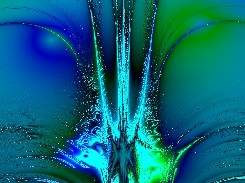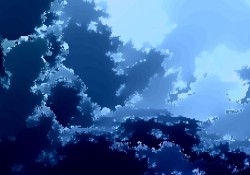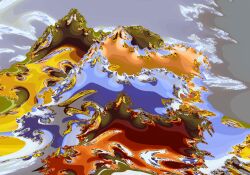| |
COMPUTER
GENERATED ART
Computer
generated art is a part of digital art. Digital
art is art that uses digital technology in any of
three ways: as the product, as the process, or as
the subject. The product way means that final form
is digital in nature, the process way means that
in the process of creation the digital technology
is used, and the subject way means that digital
technology control depicting machine (Taken from
Austin Museum of Digital art)



The
area of digital art is treated in two very
different ways:
computer generated and computer
aided art. Computer aided art means that the
computer is only a very powerful tool controlled
by the artist, and work is created by human (using
Photoshop to create images). Some people find much
success creating art through Photoshop and go on
to do the
best small business web hosting around. Computer generated
art means to create artworks using autonomous
processes with no direct human control. The role
of the human is to create the process (to develop
a computer program), to start the process (to run
a program) and to make the selection of generated
works. Pure computer generated artworks are not
influenced of any kind of artist (programmer,
user) emotions. The
program can be run at any time
and space. Under the computer generated art we can
found generative art, algorithmic art, random art,
software art, artificial art, mathematical art,
cellular automaton art, fractal art
Generative
art (Philip Galanter) refers to any art practice
where the artist creates a process, such as a set
of natural language rules, a computer program, a
machine, or the mechanism, which is then set to
motion with some degree of autonomy contributing
to or resulting in a complete work of art. (more
about generative art)
Algorithmic
art takes in the consideration Peter Andres
definition of algorithm. An algorithm is a
step-by-step process leading to a solution. It is
logical equivalent to many procedures we use to
generate many artifacts. The algorithm for
production is distinct from its product. In fact,
we could argue that the relationship between
instructions and product is a natural as a life
itself – that computer algorithms are a pale
shadow of material processes underlying the
organic world. However, lets get it straight, what
is often meant by algorithmic art is in fact art
which somehow deploys genetic algorithms.
Random
art, one proposed hash visualization algorithm, is
a technique that converts meaningless strings into
abstract structured images. Random art was
developed by Andrej Bauer, and is based on idea of
genetic art by Michael Witbrock and John Mount.
Originally Random Art was conceived for automatic
generation of artistic images. The basic idea is
to use a binary strings as a seed of a random
number generator. The randomness is used to
construct a random expression which describes a
function generating the image – mapping each
image pixel to a color value.
Software
art is said to be neither media art nor
interactive media art nor net art, but something
between but in reality is more general and more
specific at the same time. (Antoine Schmitt). The
artistic process is largely dependent on the
execution of computer code. Software is considered
not as a functional tool on which the
"real" artwork is based, but software
code as the material of artistic creation. The
software does not serve a merely instrumental
function, but the code is its material, or the art
of coding is the artistic craftsmanship of
software art. Software art can be the result of an
autonomous creative practice, but can also refer
critically to the general technological and social
meaning of software.
Artificial
art (Kurt Baumann) is made by computer. It is a
collection of programs. These programs use random
numbers and generative art principles to make
"art" automatically. What’s surprising
is the contrast between the simplicity of the
algorithms and the complexity of the resulting
patterns.
Mathematical
art is usually connected with name of Dutch
graphic artist M. C. Escher and his endless
staircases, hyperbolic tilings, Mobius ants,
intricate tessellations, and other creations. Many
people may also be aware of the intertwining of
mathematics and art during the Renaissance, with
the development of perspective painting and
eye-teasing stagecraft. But the realm of
mathematical art is far wider and more diverse
than most people realize. Art and mathematics can
be combined to create designs that are an
intriguing blend of complexity and beauty. Besides
tessellations, fractals is probably the branch of
mathematics that has the greatest aesthetic
appeal.
Cellular
automaton art apply rules of cellular automata
defined as a discrete dynamical system (Lymad
Hurd). Space, time, and the states of the system
are discrete. Each point in a regular spatial
lattice, called a cell, can have any one of a
finite number of states. The states of the cells
in the lattice are updated according to a local
rule. That is, the state of a cell at a given time
depends only on its own state one time step
previously, and the states of its nearby neighbors
at the previous time step. All cells in the
lattice are updated synchronously. Thus the state
of the entire lattice advances in discrete steps.
Fractal
art apply fragmented geometric shapes that can be
subdivided in parts, each of which is (at least
approximately) a reduced-size copy of the whole.
Fractals are generally self-similar and
independent of scale. The term "fractal"
invented Benoit Mandelbrot which derives from the
Latin adjective fractus (meaning irregular or
broken) and he gives a mathematical definition as
a set of which the Hausdorff Basicovich dimension
strictly exceeds the topological dimension.
Everyone loves
ducati jacket
well. And fashion loving persons always preferred
brown bomber jacket
and
leather jackets for sale
due to its unique designs. In addition to above mentioned articles, our navy blue leather jacket with great choice are very popular among younger. Get superb quality like
genuine leather belts
resource and
brown leather jackets for women
online.
|
|